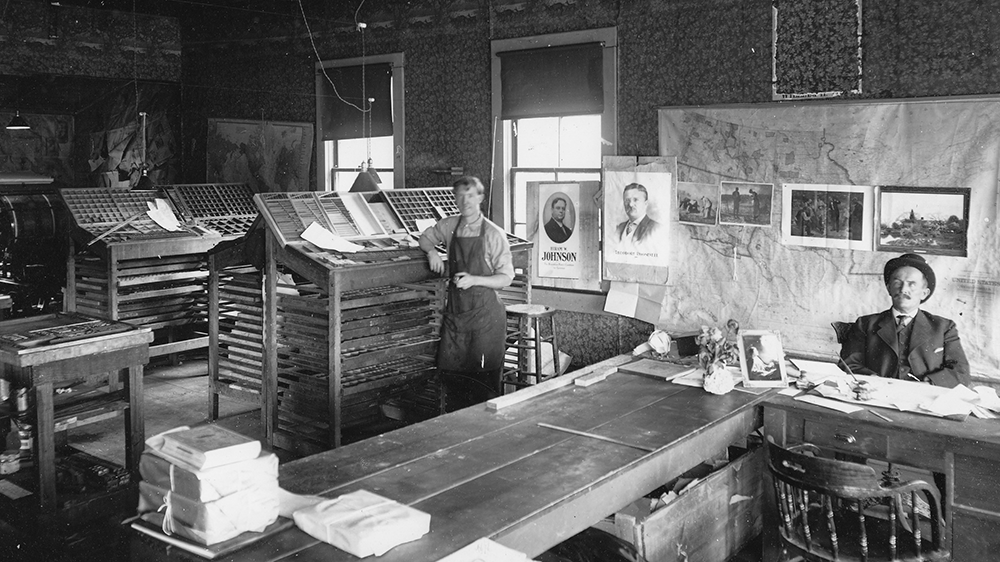
A March 1, 1938 press release proclaimed: “One of California’s great country editors, Harry E. Armstrong, 76, publisher of the Clovis Tribune, was dead today, the victim of a heart attack at his home.”
The March 8, 1938, Clovis Tribune front page tribute read: “He was a positive character who had strong opinions of what he considered right or wrong. Sometimes he kept these standards against terrific odds but ultimately his judgment was vindicated.” He and his wife Edna supported the crusade for the February 27, 1912 incorporation of the City of Clovis as a “dry” (no sale of liquor) city.
The following excerpts give us insight into the life of Clovis from 1915-1920.
“Two Christmas requests that were published in 1920: “Please send me a wagon and popgun. I’m trying to be a good boy. I lace my own shoes and I am good to my little brother. I am four years old. I saw you one day. Good Bye, Darwin.”
“Our house has no chimney. Leave me a baseball and bat and a bag of marbles at Merriman’s or at the Tribune. Mother calls me Willie but Dad and the boys call me Bill.”
1915: Clovis High graduated 22 seniors. A Ford Touring car was priced $490, Runabout $440 and a Town Car $690. Four acres of vines and trees sold for $3,000. A 25 by 150-foot Clovis lot with a view of the mountains, city water and sewer, 80-foot wide city street and a 20-foot alley cost $125.
Clovis High School District paid $1,000 for the 1909 Clovis Auditorium at the southeast corner of DeWitt and Fourth for a gymnasium and lecture hall. The First National Bank of Clovis on the northwest corner of Fifth and Pollasky stated: “Every modern woman has a bank account.”
Three cans of Pork and Beans sold for 25 cents, school shoes $1.38 to $2.50 and a loaf of bread from the Clovis Bakery was 25 cents.
1916: $8 bought 30 rides on the SP train from Clovis to Fresno and a round trip to San Diego cost $15.75. The City bought a new Ingram fire truck that failed on its basic test run. They then voted to buy a Buick. Money was loaned at 7.5 percent.
Oil speculation for 5,000 acres at the northern Garfield district just opposite the home of Isaac Ball. The derrick was 250 feet high. Stanford addition, bounded by Bullard, Sunnyside, Third and Fowler, was identified as the “neatest suburbia.” It was later dubbed “Bingville.”
A Chandler auto and horse and buggy collided at Fourth and Woodworth. A worker was bit by vicious black spider at Veith’s winery. It was urged that outbuildings should be sprayed.
1917: U.S. government annual debt was $600,000,000. Exports were down while England was recovering from recession. A trade article: “Send cotton to Switzerland for 20 cents per pound and return back as handkerchief for $4 per pound.”
Clovis Mayor Lewis Gibson: “Appalling growth of crime among youth of the land, evil, pernicious affects of pool rooms and the viscous picture show. No decency or morality.”
Lee Mow, owner of the Chinese Chow restaurant, located on the northwest corner of Fulton (Clovis) and Sixth, feared for his life during a Tong War and left Clovis for a few months.
Mrs. Jane Cole, 88 years old and mother of 10 daughters, had knitted for four wars: Mexican, the War of Rebellion (U.S. Civil War), Spanish War and WWI.
1919:Ad from a Clovis Furniture store on the southwest corner of Clovis and Fourth: “Disease-germs lurk in old wall paper.” Sgt. Peter Rossi married a French girl. It was the first Clovis war romance.
Water level was low, dropped to 7-9 feet. Water ditches to Forkner fig tract, $2 per acre.
Constable Charles Clifford declared punch boards were unlawful. Woman’s Club believed Clovis could be beautified by lowering water rates and adding adequate street lights.
1920: Flu epidemic closes schools, churches and civic centers. Constable Clifford stated that tramps in Clovis had no excuse for idleness. They were located under packing houses on Clovis Avenue.
Realtor Frank Drury ad: “This is prosperity, raisins 15 cents per pound, peaches 17 cents per bound. Buy a home.” D.C. Sample was injured at Ockenden during a stampede of 450 cattle.
Twenty percent of California residents are nomadic agriculture workers. America’s three curses, movies, pool hall and public dance hall. 104,000 horses in Army during WW I. President’s experts ordered 945,000 saddles.
It happened here in Clovis. It is a part of our rich heritage.








